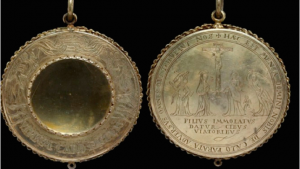This small round container (8.2 cm in diameter) is a silver pyx, used to protect and transport the Blessed Sacrament. Made in England at the turn of the seventeenth century, its history is uncertain; it may have been associated with recusant Catholicism in post-Reformation England. The words ‘VERBUM CARO FACTUM’ are engraved around the edge on the front of the pyx. Visible through the glazed panel, the consecrated Hosts would have been framed by these words, and venerated by the two tiny angels above. On the reverse of the pyx, Christ on the cross is framed by Moses and the serpent, and Abraham and Isaac – two Old Testament prefigurations of the Crucifixion. There are also further Latin inscriptions: ‘FILIVS IMMOLATUS DATVR CIBVS VIATORIBVS’ (‘The son who was sacrificed is given as food to travellers’) and ‘+ HÆC EST MENSA DOMINI NOBIS DE CÆLO PARATA ADVERSVS OMNES QUI TRIBVLANT NOS’ (This is the table of our Lord prepared for us from Heaven against all those who bring us tribulation’). Through this object, the Word made flesh becomes a portable source of nourishment to be consumed anywhere, not just at the altar.
Victoria and Albert Museum
Museum no. M.18-2012
Image: Victoria and Albert Museum
